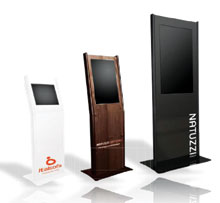HIGH POINT -- Two companies have partnered to bring the latest in furniture kiosks to retail showrooms designed to drive purchase conversions, allow manufacturers to provide consistent brand management and help dealers take some of the sting out of showrooming.

Consumers can use these computerized kiosks from Eyeconic and GET Interactive in Natuzzi stores. The companies plan to announce other users of the kiosks early next year.
The companies are Kentucky-based Eyeconic, headed by CEO Jeremy Jacobs, and North Carolina-based GET Interactive, a home furnishings-specific company headed by industry veteran Rick Harrison.
Kiosks serve as computerized way stations that allow consumers to do everything from perusing manufacturers' product catalogs to buying product and scheduling delivery.
The kiosks are already in use at Natuzzi. The companies say they plan to announce other users at the winter Las Vegas Market.
Among the capabilities of the kiosk, the companies say, are driving sales by giving consumers more product choices via a kiosk catalog, incorporating third party technology such as room planners and fabric drapery capabilities to allow consumers to customize products, taking credit applications and telling consumers (and the store) how much credit they have to spend. Kiosks also allow consumers to swipe a card, make a purchase and schedule delivery.
Since it can do several things a sales associate traditionally does, it can also be a tool for reducing staff costs and training, the companies say.
"This is a broad-based integrated solution," said Harrison, maintaining that less enlightened equipment can be nothing more than "a glorified catalog. This provides the opportunity to take every single one of the retailer's goals from a marketing and/or commerce perspective and couple them with manufacturers' goals, and push them forward into an engaged retail environment that allows consumers to accomplish their goals right at the point of contact.
"The brand can tell the story, the retailer can tell his story, it can take place there on the screen," he added. "Consumers can design their own products and schedule delivery and a transaction can take place right there on the screen."
Since the kiosk program is an integrated solution, manufacturers aren't required to reinvent the wheel and can use systems they already have, he said.
The companies recently added MicroD video catalog capabilities, and have incorporated other solutions to allow a kiosk program to be friendly to programs already used by the industry.
"This can be customized. At the top of your macro level, it's an instantaneous global tool. Push a button and everybody gets the same thing everywhere. Conversely, this can be customized down to a single store," Harrison said.
Specifically, if a retailer has stores in both high-end and modest neighborhoods, it can tailor sales accordingly, using higher-end product in more ritzy areas. Other information also can be targeted to locations, such as a specific sofa "available at this store only."
"It's a one-stop technology shopping center," said Jacobs.
Kiosks can also push products that a manufacturer aggressively wants to promote.
The system also provides analytics and tracking "to know which buttons people are touching so you can say, "Hey, this isn't working'," said Jacobs. "Maybe you thought something was important to your customers but it doesn't seem to be. You can make the real estate on the kiosk work for you."
For consumers who "showroom" - shop at stores and then buy online if they find a better price - the kiosk is an if-you-can't-beat-them, join-them tool, the companies say. A dealer can include Internet access at a kiosk so consumers can compare prices on-site, giving the retailer an opportunity to match the price or offer offsetting incentives to go for the sale.





